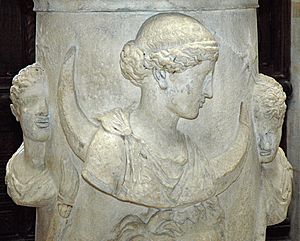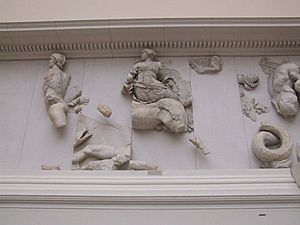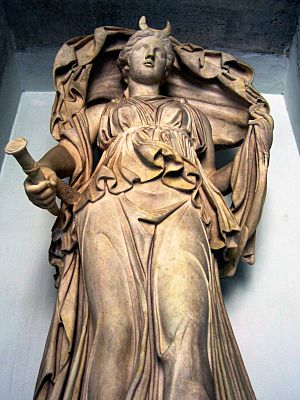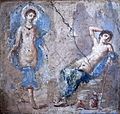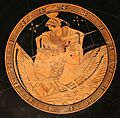Selene facts for kids
- Selene is another name for the moon.
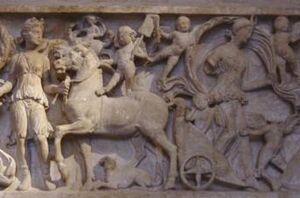
Selene is the goddess of the moon in Greek mythology. She is one of the Titans, who were powerful gods before the Olympian gods. Her parents were Hyperion and Theia.
Over time, Selene became linked with the goddess Artemis. In Roman mythology, the moon goddess is called Luna. Luna is the Latin word for "moon." The Roman Luna later became linked with the goddess Diana.
Selene is an important goddess in the Greek pantheon (the group of all gods). Her name might come from the Greek word selas, which means "light." The word selenology, which is the study of the geology of the Moon, comes from her name. Also, the chemical element Selenium was named after Selene.
Contents
How Selene Is Shown
In art from after the Renaissance (a period of history), Selene is often shown as a beautiful woman with a pale face. She sometimes rides a silver chariot (a two-wheeled cart) pulled by oxen or two horses.
Sometimes, she is shown riding a single horse or a bull. She often wears long robes and has a half-moon on her head. She might also carry a torch.
Myths and Stories
Selene's Family
In ancient Greek stories, Helios, the sun god, is Selene's brother. After Helios finishes his journey across the sky, Selene begins her own trip. She is said to wash in the waters of the Ocean before starting her night journey.
As night falls, the Earth is lit by the light from her head and golden crown. When she grows bigger after the middle of the month, it is a clear sign to people. Her sister, Eos, is the goddess of the dawn. Eos also had a human lover, Cephalus, which is similar to the story of Selene and Endymion.
Later writers sometimes said Selene was the daughter of Zeus, like Artemis. Others said she was the daughter of Pallas the Titan.
Selene's Lovers
One of the most famous stories about Selene is her love for a mortal man named Endymion. He was a very handsome hunter, shepherd, or king from Asia Minor. Selene loved him so much that she asked Zeus to let him sleep forever. This way, he would never leave her.
Another version of the story says Endymion chose to live forever in sleep. Every night, Selene would visit him on Mount Latmus, near Miletus. Selene and Endymion had fifty daughters, called the Menae. One of their daughters was Naxos, the nymph of Naxos Island.
The Homeric Hymn to Hermes also says that Selene had a daughter named Pandia with Zeus. Pandia means "utterly shining" and represents the full moon. Some stories also say that the Nemean Lion was her child. In the Homeric hymn, Selene's chariot is pulled by horses with long manes.
Luna, the Roman Moon Goddess
The Roman moon goddess, Luna, had a temple on the Aventine Hill in Rome. It was built in the 6th century BC. However, it was destroyed in the Great Fire of Rome when Nero was emperor.
There was also a temple to Luna Noctiluca ("Luna that shines by night") on the Palatine Hill. People celebrated Luna with special parties on March 31, August 24, and August 29.
Images for kids
-
A bronze statuette from the Roman-era showing Selene or Nyx (Night) with a flowing veil, at the Getty Villa.
-
Selene and Endymion, from an ancient fresco found in Pompeii.
-
An Attic Kylix (a type of drinking cup) showing Selene and her horses, around 490 BC, made by the Brygos Painter.
-
A coin from the Kushan ruler Kanishka I (around AD 127–151). It shows Selene with lunar horns and the Greek word "CAΛHNH."
See also
 In Spanish: Selene para niños
In Spanish: Selene para niños


